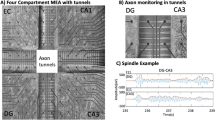Summary
The structure-activity relationship of two isomeric 1-aminoadamantanes, 1-C-ethylaminoadamantane (D 174) and 1-amino-3-ethyladamantane (D 175), on membrane anisotropy and the excitability of neurons was studied in the CNS of the rat and in the decerebrated cat. Mass spectrometric analysis showed that after a single, 40 mg/kg dose, D 174 and D 175 were unevenly distributed within the CNS of the rat, moreover the distribution pattern of the two substances was different. As measured by fluorescence depolarization in controls the membrane anisotropy was found to be higher in the older parts as compared with the younger parts of the CNS. After i.p. application of 40 mg/kg the membrane anisotropy was reduced in the cortex by D 174, whereas D 174 and D 175 increased the rigidity in striatal membranes. If cortical membranes were incubated with the substances, the fluidizing effect of D 174 was more prominent than that of D 175. In the decerebrated cat only D 174 in a dose of 5 mg/kg i.p. raised the discharge of spinal alpha-motoneurones significantly. The results suggest that the membrane architecture is more affected by D 174 as compared with D 175 which is reflected by a greater effect on membrane anisotropy as well as on the activity of spinal alpha-motoneurones.
Similar content being viewed by others
References
Block F, Holtwick L, Heim C, Sontag K-H, Turski L, Klockgether T (1987) Biphasic action of 1-amino-adamantane derivatives in open field behavior and their effects on muscle stretch tension. In: Abstracts of the Tenth International Congress of Pharmacology, Sydney, August 23–28, P-215
Chaykowski FT, Wan JKS, Singer MA (1979) Interaction of small molecules with phospholipid bilayer membranes: a spin label study. Chem Phys Lipids 23: 111–123
Colman RK, Kuchibhotla J, Jain MK, Murray RK (1977) Phase separation in phosphatidylcholine bilayers as a predictor of inhibition of blood platelet aggregation by amantadines. Biochim Biophys Acta 467: 273–279
Eldred E, Granit R, Merton P (1953) Supraspinal control of the muscle spindles and its significance. J Physiol 122: 498–523
Fischer PA, Jacobi P, Schneider E, Schönberger B (1977) Die Wirkung intravenöser Gaben von Memantin bei Parkinson-Kranken. Arzneimittelforschung 27: 1487–1489
Grossmann W, Schütz W (1982) Memantin und neurogene Blasenstörungen im Rahmen spastischer Zustandsbilder. Arzneimittelforschung 32: 1273–1276
Henkel JG, Hane JT (1982) Structure-anti-Parkinson activity relationships in aminoadamantanes. Influence of bridgehead substitution. J Med Chem 25: 51–56
Heron DS, Shinitzky M, Hershkowitz M, Samuel D (1980) Lipid fluidity markedly modulates the binding of serotonin to mouse brain membranes. Proc Natl Acad Sci USA 77: 7463–7467
Johnson RG, Carty SE, Scarpa A (1981) Accumulation of amantadine by isolated chromaffin granules. Biochem Pharmacol 30: 763–769
Lowry OH, Rosebrough NJ, Farr AL, Randall R (1951) Protein measurement with the Folin phenol reagent. J Biol Chem 193: 265–275
Osborne NN, Beale R, Golembiowska-Nikitin K, Sontag K-H (1982) The effect of memantine on various neurobiological processes. Arzneimittelforschung 32: 1246–1255
Sachs L (1968) Statistische Auswertungsmethoden, 1st edn. Springer, Berlin Heidelberg New York, pp 293–298
Sakaruda O, Kennedy C, Jehle J, Brown JD, Carbin GI, Sokoloff L (1978) Measurement of local cerebral blood flow with iodo-[14C]antipyrine. Am J Physiol 234: H59-H68
Schwab RS, England AC, Poskanzer DC, Young RR (1969) Amantadine in the treatment of Parkinson's disease. J Am Med Assoc 208: 1168–1170
Sontag K-H, Wand P, Cremer H, Mühlberg B (1975) The proprioceptive activation of the stretch tension in pretibial flexor muscles induced by stimulation of antagonistic muscle afferents. Arch Ital Biol 113: 44–62
Sontag K-H, Wand P, Schwarz M, Wesemann, W, Osborne NN (1982) Die Wirkung von Memantin auf spinale alpha-Motoneurone und auf Gehalt von Dopamin, Noradrenalin und Serotonin des Striatums und lumbalen Rückenmarks. Arzneimittelforschung 32: 1236–1240
Tayyaba K, Hasan M (1985) Vitamin E protects against metasystox-induced adverse effect on lipid metabolism in the rat brain and spinal cord. Acta Pharmacol Toxicol 57: 190–196
Wesemann W, Schollmeyer JD, Sturm G (1977) Gaschromatographische- und massenspektrometrische Untersuchungen über harnpflichtige Metabolite von Adamantanaminen. Arzneimittelforschung 27: 1471–1477
Wesemann W, Dette-Wildenhahn G, Fellehner H (1979) In vitro studies on the possible effects of 1-aminoadamantanes on the serotonergic system in M. Parkinson. J Neural Transm 44: 263–285
Wesemann W, Muschalek G, Stöltzing, H, von Pusch I (1981) Effect of 1-aminoadamantane on adenine nucleotide and serotonin storage in blood platelets. Eur J Cell Biol 26: 158–167
Wesemann W (1983) Adamantanamine—Neurobiologische Untersuchungen zur klinischen Wirkung einer polyzyklischen Verbindungsklasse mit diamantähnlicher Struktur. Funkt Biol Med 2: 137–145
Wesemann W, Weiner N (1985) Effect of membrane fluidity on serotonin binding to rat brain membranes. J Neurochem [Suppl] 44: S 76-D
Author information
Authors and Affiliations
Rights and permissions
About this article
Cite this article
Melzacka, M., Block, F., Weseman, W. et al. Effects of two isomeric 1-aminoadamantanes on the membrane anisotropy and on alpha- and gamma-motoneurones excitability. J Neural Transm Gen Sect 1, 153–164 (1989). https://doi.org/10.1007/BF02248665
Received:
Accepted:
Issue Date:
DOI: https://doi.org/10.1007/BF02248665




